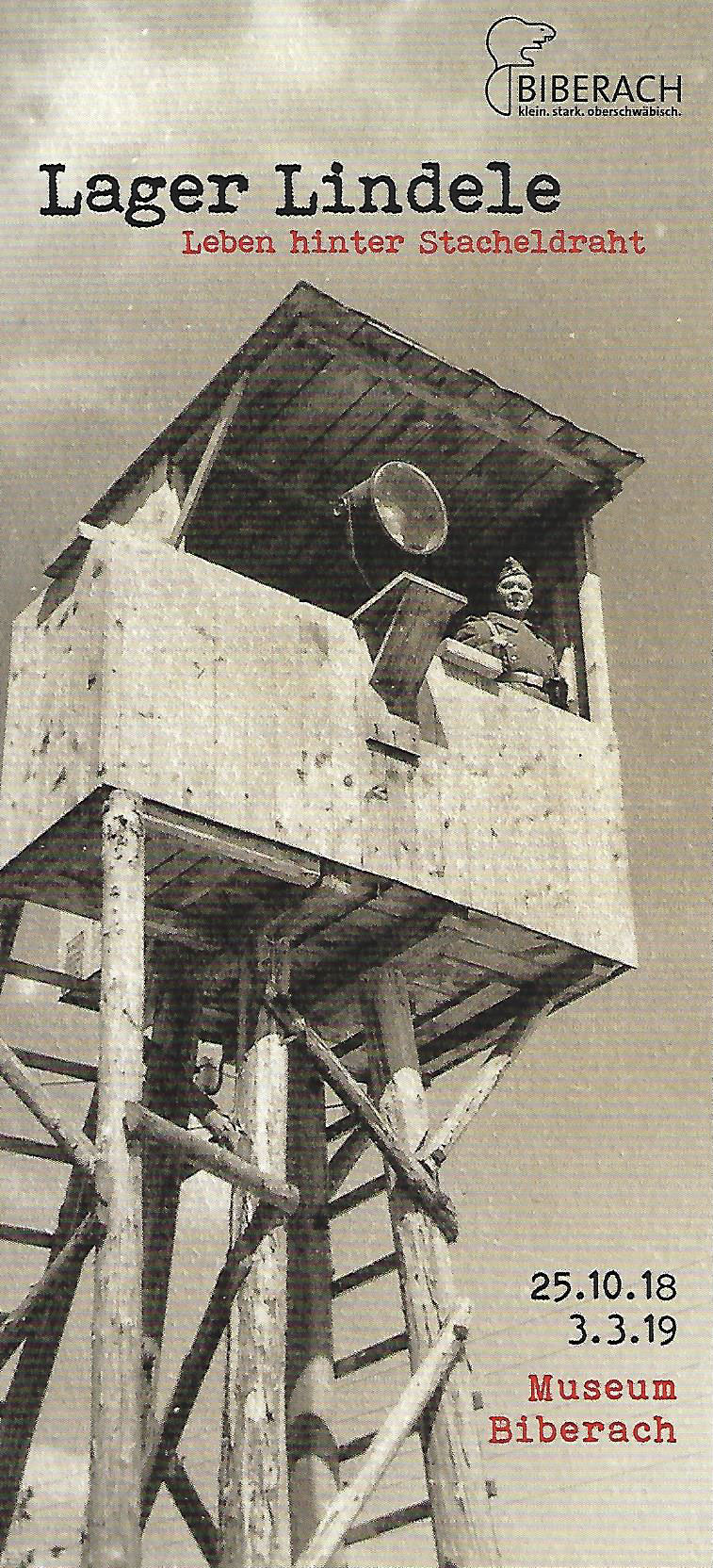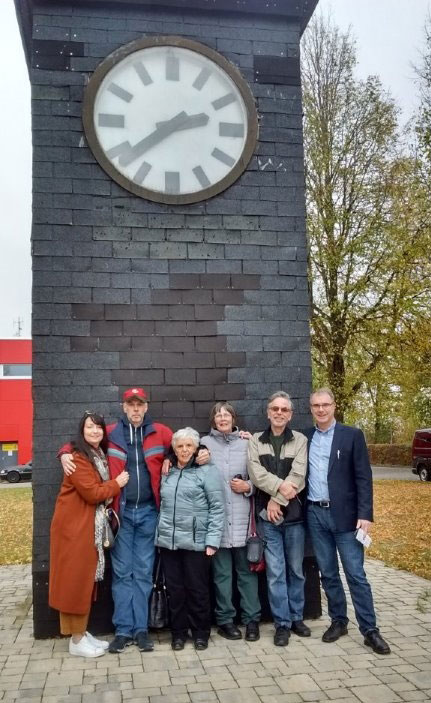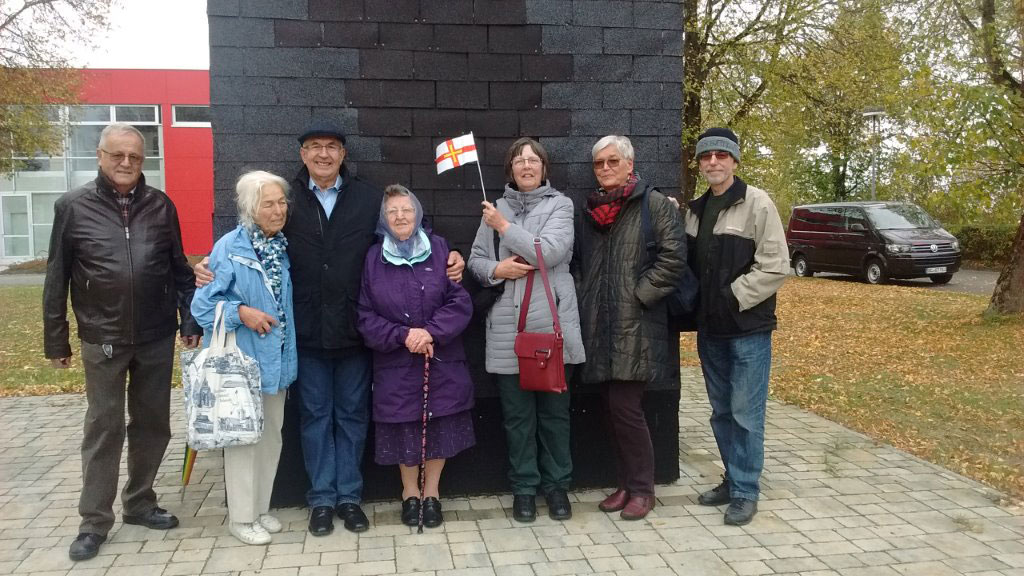Camp Lindele – Life behind Barbed Wire
Opening of the special exhibition at Biberach Museum on 24 October 2018, as reported in two articles from the Schwäbische Zeitung.
The exhibition runs until 03 March 2019.
Schwäbische Zeitung Newspaper Article
Friday 26 October 2018
Bitter Pills with a wonderful effect – Biberach Museum shows “Camp Lindele – Life behind Barbed Wire”.
400 visitors showed interest and appreciation for the opening of an exhibition at the Biberach Museum on Wednesday. The title: “Camp Lindele – Life behind Barbed Wire“
A sharp contrast became visible between the depressing theme and the people present. Instead of dark misery, happy laughs were heard, and Rotraud Rebmann, Nellie Le Feuvre and Dudley Bradley are so to speak the reflection of the emotions. Very intimate and in relaxed composure they stand together, and their love of life seems surrealistic in front of swastika signs.
Realistic are the events of that time: where there is a Police College today, there had developed out of the original 1939 barracks a camp for POWs and deportees, and over 1,000 people from the Channel Islands of Jersey, Guernsey and Sark were interned.
Realistic is also the turning point: it began with childbirths or with work on farms or in gardens from when friendships developed, even now alive in third generations. “The Exhibition is a valuable contribution of our museum to a reflection for us“, said Mayor Norbert Zeidler, “a reflected picture from which nothing can be wiped off, irradicated or forgotten …. Our relationship is something very special, originating out of a bitter heritage leading to something very precious …. The common heritage must lead to common remembrance.
It seems to be incredible that the friendship link developed out of the misery within the showcase of the German camp system. Museum director Frank Brunecker interprets the presence of Bristish guests this evening as a hopeful historic lucky chance and he shows that countless German and British names are connected with this ambitious project. His texts about Reinhold Adler‘s research revived three years of camp life, fate and deprivation.
The private memorabilia on the upper floor were this evening accompanied by a relaxed atmosphere from the foyer and the comforting klezmer music played by four teachers from the Music School. The exhibition itself is irritating, stirring and shameful. One could despair when realising what people can do to other people. Yet despite hatred the affected and their descendants show, in human generosity, friendship and trust. Between Biberach and Guernsey a fast bond of reconciliation was formed and that makes the exhibition easier to bear.
A film about a carnival, or the innocent look on Mary Carswell’s face while being registered in the camp, as well as a decorated tin cup leads to a lump in the throat.
Painful tragedy and shameful senselessness cannot be smoothed over, neither by an order awarded by Queen Elizabeth, nor by an exhibition. The visits from both sides could. This is why so many observers have tears in their eyes when Rotraud Rebmann, Nellie Le Feuvre and Dudley Bradley embrace each other. Nellie Le Feuvre lived in Lager Lindele as a sixteen-year-old, her cousin Dudley Bradley was born in Biberach in 1943. There is life after camp life and an evening full of affection, respect and conciliatory memory.
Schwäbische Zeitung Newspaper Article
Saturday 27 October 2018
Hitler’s hostages in Biberach
An exhibition at the museum illustrates the life of the internees from Guernsey
Not quite a minute had passed when right at the beginning of the reading passage Nellie Le Feuvre’s voice broke. In the foyer of the Biberach Museum she tells about the moment, when her 8-year-old brother Vivian was separated from her and her mother on their arrival at the Biberach Camp. Despite the long time that has passed since, the memory is too painful.
In autumn 1943 Nellie was 16 years old and belonged to a group of altogether 1,000 deportees from the Channel Islands of Guernsey and Sark. They were Hitler’s hostages. He had ordered to deport them to Germany as a reprisal for Germans interned in Iran – men, women and children became prisoners of Hitler. Living in barracks surrounded by barbed wire they tried to lead a normal life as far as possible. Their time at the camp is illustrated in a small exhibition at the Biberach Museum. Former deportees like Nellie Le Feuvre and her cousin Dudley Bradley came especially for the opening of the exhibition.
The story of the Biberach Camp Lindele begins with Winston Churchill demilitarising the Channel Islands in 1940 and leaving them facing their fate: the invasion ofthe German troops. It seemed to be too difficult to defend the islands in the English Channel. Politically they then and now did and do not belong to the United Kingdom. The 2,000 hostages of Hitler from Jersey, Guernsey and Sark were, however, mostly British citizens. From September 1942 they were taken to Dorsten in Westfalia, Biberach and Bad Wurzach. So was the family of Irene Shorrock, one of the 27 “Biberach babies“, born in custody.
Now she is here in the Biberach Museum and tells us, how her mother had to go to Ochsenhausen hospital to give birth because the Biberach hospital could take no more patients, being full with injured soldiers. On 26 April 1945 she was born, on one of the last days of war. She was meant to be named Patricia because of Irish ancestors, but a nun suggested the name Irene, meaning peace in Greek – something everybody was longing for.
Irene has no memories of life in the camp, but Nellie Le Feuvre has. She tells how she and her friend made icecream with snow and condensed milk. This and other tinned food was what the deputies had enough, as the Red Cross Parcels contained mainly preserved food. The camp at that time was a ‘showcase‘, as Herr Brunecker, historian and director of the museum, pointed out, and could therefore not be compared with concentration camps in Eastern Europe.
There was a school for the over 170 children, theatre performances and concerts. The deportees came from all social classes, craftsmen were represented as well as teachers, clergymen and two doctors who worked closely together with the camp nurse Anni Sigg. It is known that about 80 male internees worked for German craftsmen and therefore had contacts with Biberach families.
And yet, “This was not Carnival in August“ which is the title of the book that describes the history of the camp in detail. The former Biberach history teacher Reinhold Adler published it in 2002 and refers to the parade in the camp in August 1943. Adler, however, not only reports about social events, but also about difficulties within the close community from different social classes in very limited space. He also mentions youngsters with abounding energy who had to watch their German counterparts when they, for example, raced down the Lindele slope on sleighs and skis, whereas they themselves were not allowed to leave their small community behind barbed wire.
But Frank Brunecker clearly points out: these problems were nothing compared to those of former inmates of Camp Lindele, which had been installed as military barracks in 1939.“Here we have a gap, which I am very upset about“, says Brunecker and mentions that very little is known about the Russian POWs: 3,000 of altogether three million Russian prisoners came into the camp in the winter of 1941/42. In that winter several thousand men died due to malnourishment and diseases. Or they were shot on arrival. “We have no photograph and no object from these maltreated people. Nothing. Therefore there is nothing we can exhibit.“ This is Brunecker‘s sad summary. Only the Russian cemetery has remained. It reminds us of what the National Socialists called “Shadow Camp“.
“I have never felt any hatred against the Germans“ says the 91-year-old Nellie Le Feuvre today. Not then, and not now. That many former deportees think like this is also Helga Reiser’s experience. Her husband Hans Peter Reiser was born in Biberach in 1943. His mother was in the same hospital room with the mother of Carole Wheatley from the camp. From this meeting a friendship for life originated, first between the parents, then the children.
It is these friendships that led to the founding of ‘Biberach Friends of Guernsey‘. “There are, however, also former deportees, who do not want to have anything to do with Germany.“ says Helga Reiser, and she understands.




